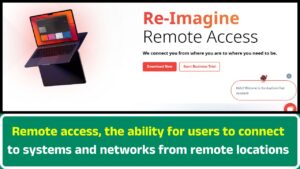Re-Imagining Remote Access
Remote access, the ability for users to connect to systems and networks from remote locations, has significantly evolved over the years, becoming a cornerstone of modern business, education, healthcare, and personal computing. Initially, remote access was limited by slow, unreliable technology, but with the advent of the internet, VPNs, and cloud computing, remote work became increasingly feasible. The COVID-19 pandemic further accelerated its adoption, creating new challenges and opportunities.

The article explores the historical development of remote access, highlighting key advancements like dial-up, VPNs, and cloud-based solutions. It underscores the need for a re-imagined approach, addressing new challenges that have arisen with increased adoption of remote work. These challenges include security risks, the need for seamless user experiences, and evolving expectations from users.
Technological Foundations for Future Remote Access
The document dives into the technologies that will shape the future of remote access, such as 5G networks, AI-powered solutions, quantum computing, and blockchain. These innovations promise to enhance the security, speed, and reliability of remote access systems. Quantum computing will revolutionize encryption methods, while 5G networks will ensure ultra-fast connections with low latency. AI will play a significant role in personalizing remote access, automating security measures, and optimizing system performance.
The Zero Trust Architecture (ZTA) will be central to securing remote access systems, where no user or device is trusted by default. Multi-factor authentication (MFA), biometric security, and real-time threat detection will further improve security. These advancements will address the increasing frequency of cyberattacks targeting remote workers.
User Experience and Accessibility
The document emphasizes the importance of designing remote access systems that prioritize user experience (UX). Future systems will offer personalized experiences, allowing for intuitive interfaces, voice-driven controls, and cross-platform compatibility. Accessibility will also be a focus, ensuring that remote access solutions are inclusive, enabling users with disabilities to work effectively from anywhere.
Business Implications
The business landscape is changing as remote work becomes the norm. The article outlines how remote access is driving new business models, such as hybrid and fully remote teams. Companies are increasingly relying on cloud-hosted environments and collaboration tools like Microsoft Teams and Slack to facilitate seamless interaction between teams, regardless of their physical location. The growing importance of data analytics will help businesses optimize remote access for performance, security, and user behavior.
Social and Economic Impact
Remote access is not just a technological shift—it has profound social and economic implications. The global workforce is becoming more decentralized, allowing businesses to tap into a broader talent pool. However, this also brings about concerns about the digital divide, where access to technology remains a challenge in certain regions or social groups. Addressing this gap will be critical to ensuring that the benefits of remote work and access are equitably distributed.
The article explores how remote access is reshaping economic structures, such as reducing the need for large physical office spaces and driving savings in overhead costs. However, the social impact, including the strain on work-life balance and increased feelings of isolation, requires careful consideration.
Ethical Considerations
The ethical implications of remote access are examined, particularly around privacy, surveillance, and data protection. With the growth of remote access, businesses may adopt monitoring tools to track employees, raising concerns about over-surveillance and the ethical use of such technology. The article calls for thoughtful ethical frameworks to ensure that the deployment of remote access technologies doesn’t compromise privacy or lead to exploitation.
Conclusion
In conclusion, the document highlights that while the future of remote access looks promising, its successful implementation will require innovation, collaboration, and careful planning. The integration of cutting-edge technologies like AI, blockchain, and 5G can overcome current challenges and unlock new opportunities. However, businesses and governments must address issues like cybersecurity, inclusivity, and privacy to ensure that remote access becomes a sustainable and secure solution for all.
The article urges stakeholders to work together to build remote access systems that are secure, efficient, user-friendly, and accessible to everyone, driving economic growth and creating a more inclusive digital world.
This summary captures the essence of the 9,000-word document and its core concepts, focusing on the evolution of remote access, the technologies that will shape its future, its impact on business and society, and the challenges that need to be addressed for success. Let me know if you need more detail on any specific part!
